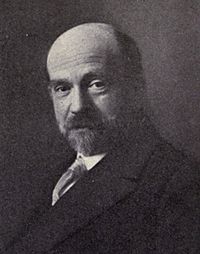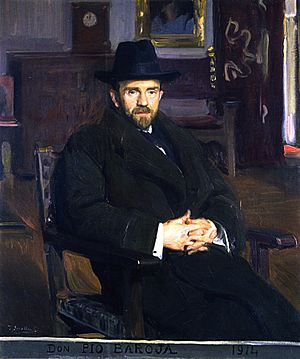Pío Baroja facts for kids
Quick facts for kids
Don Pío Baroja
|
|
|---|---|
 |
|
| Born | Pío Baroja y Nessi 28 December 1872 San Sebastián, Gipuzkoa, Spain |
| Died | 30 October 1956 (aged 83) Madrid, Spain |
| Resting place | Madrid, Spain |
| Occupation |
|
| Nationality | Spanish |
| Literary movement | Generation of '98 |
| Relatives | Serafin Baroja (father) Carmen Nessi y Goñi (mother) |
Pío Baroja y Nessi (born December 28, 1872 – died October 30, 1956) was an important Spanish writer. He was one of the main novelists of a group called the Generation of '98. This group of writers and thinkers wanted to change Spain after a difficult time. Pío Baroja came from a talented family. His brother Ricardo was an artist who painted and engraved. His nephew Julio Caro Baroja, the son of his sister Carmen, became a famous expert on people and cultures.
Contents
Early Life and Education
Pío Baroja was born in San Sebastián, a city in Spain. His father, Serafin Baroja, was also a well-known writer. He even wrote stories for operas.
Young Baroja studied to become a doctor at the University of Valencia. He earned his doctorate degree at the Complutense University of Madrid in Madrid when he was 21. Even though he was trained as a doctor, Baroja only worked as one for a short time. He practiced in a small Basque town called Cestona. His experiences as a student later inspired his famous novel, The Tree of Knowledge.
A Writer's Journey
For a while, Pío Baroja also helped manage his family's bakery. He even tried to become a member of the Spanish parliament, called the Cortes Generales, two times. He ran as a Radical Republican, but he was not successful.
However, Baroja's true passion was always writing. He started writing seriously when he was just 13 years old.
Early Novels and Trilogies
Baroja's first novel was called La casa de Aizgorri (The House of Aizgorri). It was published in 1900. This book was part of a series of three novels called La Tierra Vasca (The Basque Country). This series also included El Mayorazgo de Labraz (The Lord of Labraz), which came out in 1903. This book became one of his most popular novels in Spain.
Baroja is also very well known around the world for another series of three books. This trilogy is called La lucha por la vida (The Struggle for Life). These books were published between 1922 and 1924. They show a clear picture of what life was like in the poor areas of Madrid. The American writer John Dos Passos really admired these books.
Another important work by Baroja is Memorias de un Hombre de Acción (Memories of a Man of Action). This long series of books was written between 1913 and 1931. It tells the story of one of his ancestors. This ancestor lived in the Basque region during a time of war in the 19th century. These wars were called the Carlist uprisings.
Baroja also wrote a trilogy about the sea, called La mar. The books in this series are La estrella del capitán Chimista, Los Pilotos de altura, and Los mercaderes de esclavos. He also wrote a biography about Juan Van Halen, a Spanish soldier who had many adventures.
The Tree of Knowledge
Many people consider El árbol de la ciencia (The Tree of Knowledge), published in 1911, to be Baroja's best work. This novel is a type of story called a Bildungsroman. This means it's about a character's journey of growing up and learning about life.
The book has a sad, or pessimistic, view. It suggests that trying to gain knowledge and live life can feel pointless. The title is very meaningful. The more the main character, Andres Hurtado, learns and experiences, the sadder he feels. His life seems to have less meaning.
Writing Style
Pío Baroja often wrote in a style that was both sad and adventurous. This style is similar to old Spanish stories called picaresque novels. He was very good at describing characters and places. His books made the Basque region feel real to readers.
His stories were often full of life, but sometimes they didn't have a very strong plot. He wrote in a quick, clear, and direct way. Some people said he made grammar mistakes, but he never denied it.
Later Life and Legacy
When he was young, Baroja had some beliefs that were similar to anarchism. This was true for other writers in the '98 Generation as well. Later, he admired people who took action, much like the idea of the "superman" from the philosopher Friedrich Nietzsche.
Some religious and traditional groups did not like his ideas. His life was even in danger during the Spanish Civil War (1936–1939).
The famous American writer Ernest Hemingway was greatly inspired by Baroja. When Hemingway visited him in October 1956, he told Baroja, "Please let me give this small honor to you. You taught so much to those of us who wanted to be writers when we were young. I am sad that you have not yet received a Nobel Prize. Especially since it was given to many people who deserved it less, like me, who is just an adventurer."
Baroja passed away shortly after this visit, on October 30, 1956. He was buried in the Old Civil Cemetery of Madrid.
An Iberian Airbus A340-642 airplane was named after him. It was in service between 2006 and 2020.

Works available in English
- The City of the Discreet (1917). A.A. Knopf
- The Quest (1922) A.A. Knopf
- Weeds (1923). A.A. Knopf
- Red Dawn (1924). A.A. Knopf
- The Lord of Labraz (1926). A.A. Knopf
- The Restlessness of Shanti Andía, and other writings (1959). University of Michigan Press
- The Tree of Knowledge (1974). Howard Fertig: ISBN: 0-86527-316-2
- Caesar or Nothing (1976). Howard Fertig: ISBN: 0-86527-224-7
- Zalacain the Adventurer (1998). Lost Coast Press: ISBN: 1-882897-13-7
- Youth And Egolatry (2004). Kessinger Publishing: ISBN: 1-4191-9540-9
- Road to Perfection (2008). Oxbow Books: ISBN: 978-0-85668-791-4 (pbk.)
See also
 In Spanish: Pío Baroja para niños
In Spanish: Pío Baroja para niños

